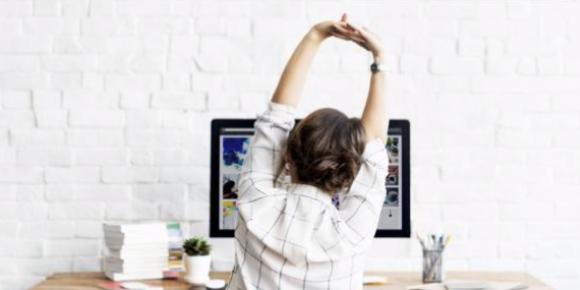
DIY stretches help you to avoid back strain and injury
Prolonged sitting, sub-optimal desk arrangements, and poor posture habits while using technology all affect your spine and, subsequently, your nervous system. When the fibrous connective tissue (your fascia) that attaches your muscles to your bone atrophy or tighten, you can experience more than just stiffness. Inactivity or limited mobility in any part of the body can yield a combo of chronic tension and atrophy when practiced repetitively – not to mentioned pinched nerves and compressed blood vessels leading to other health complications.
Poor posture and movement habits result in tightness through the muscles and tissues (like ligaments, tendons, and even the skin itself) which is all part of the fascial system. Imbalanced tension developed in the body through poor movement and posture habits creates a chronic and persistent postural deviance. Frequent stretching is an effective way to remedy the physical ailments of stiffness, immobility, and lack of coordination.
You might also decide to use all the extra free time you have right now to amp up your exercise routine. We get it, getting out for a solo run can do a lot to relieve anxiety. But, it can also cause muscle stress and tightness. Active muscles become shorter due to the spasms and contractions of exercise. This is both good or bad depending on the type of exercise you’re doing. Active muscles have more muscle "pump" or better blood flow through consistent use, improving mobility as well as decreasing adhesive tissue like scars and trigger points. But exercising with a small range of repetitive motion (like jogging) can cause unhealthy tightness. It programs the muscles and fascia into remaining tight and springy. For short movement exercises, stretching (and proper hydration) is key to reducing injury and muscle tension.
Whether caused by inactivity and poor posture, or over-activity and over-extension, tightness limits mobility and range of motion, which compounds over time, resulting in pain and injury.
Why you should stretch more
If you want to counteract “desk bod” or “weekend warrior” soreness, stretching can help! Research has shown that 12 months of stretching can be as effective as strengthening exercises or manual therapy in patients with chronic neck pain. Also, patients with chronic musculoskeletal pain demonstrate an increased tolerance to stretch after three weeks of static stretching.
Proper stretching can improve your range of motion, increase flexibility, and relieve pain. Stretching also has other benefits like reducing anxiety, decreasing depression symptoms, promoting blood circulation, and regulating blood glucose levels.
Stretching improves:
Posture: Releasing imbalanced tension allows bones and joints to resume proper alignment and movement.
Circulation: Tight muscles restrict blood flow as they compress on the blood vessels that pass through the muscles and joints.
Alignment: Tight, inflexible muscles pull on bones and joints, causing the bone or joint to misalign.
Movement: Restricted muscles decrease the ability to move around pain-free.
Stretching can be loosely described in two categories: active (dynamic) and static (passive) types of stretching. An easy way to differentiate the difference between active and passive stretching is yoga. A flowing movement like sun salutations or the switch between “cat” and “cow” positions would be an active or dynamic stretch. A held position, like downward dog, or triangle, would be a passive or static stretch.
The best stretches for movement-related stiffness: Dynamic stretching
For weekend warriors, stretching improves range of motion, shortens recovery times after workouts, and improves athletic performance.
Studies show including dynamic stretching as part of a warm-up routine before exercise improves strength, agility, and endurance. It can reduce passive stiffness and increase your range of movement during exercise. Dynamic stretching is best for athletes who are running or jumping during their sport, including jogging, tennis, basketball, HIT, and aerobics.
Active stretching generally involves moving a limb through its full range of motion to the end ranges and repeating several times.
Most people should warm-up with light active stretching before exercise and use passive stretching after exercise. Be careful not to over-stretch prior to exercises that require grit or substantial effort or force. Heavy stretching can destabilize the joints and weaken the force a muscle can produce for a time after the heavy stretch, which can result in injury.
The best stretches for worker bees: Passive stretching
Tight hips, inactive glutes, a weak core, and a constant hunch are all sure-tale signs of too much sitting, and improper posture when using modern technology like computers and cell phones.
These kinds of ailments can be alleviated with static stretching. A specific position is held with the muscle on tension to the point of a stretching sensation and then relaxed and repeated in a series. This can be performed passively by a partner, or solo by using your own body weight or a sturdy prop like the floor, a chair, or a doorway.
Static or passive stretching is the type used during rehabilitation. Static stretching is prescribed to increase muscle length and to align facia to allow for muscle healing. Static stretching is also beneficial for athletes requiring flexibility for their sports – things like gymnastics and dance. Passive stretches are great for pushing new boundaries of mobility through hydrated tissues with good circulation, which is great to do after exercise.
As with any exercise, start light and gradually migrate to more resistance when stretching. Be sure to ease out of heavy stretches instead of just "popping" out of the position, to avoid an involuntary spasm.

